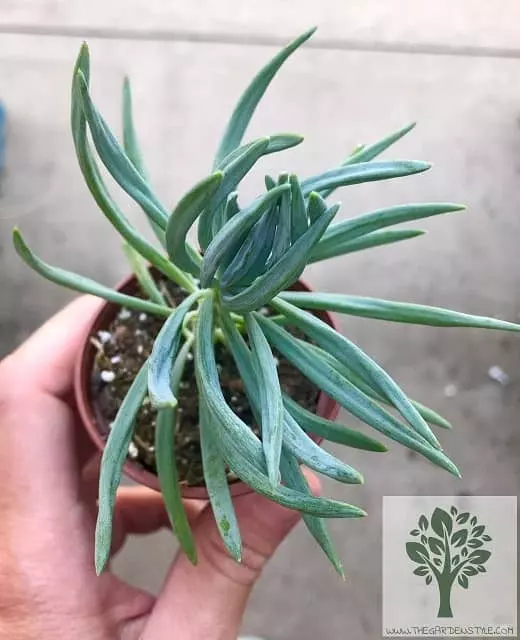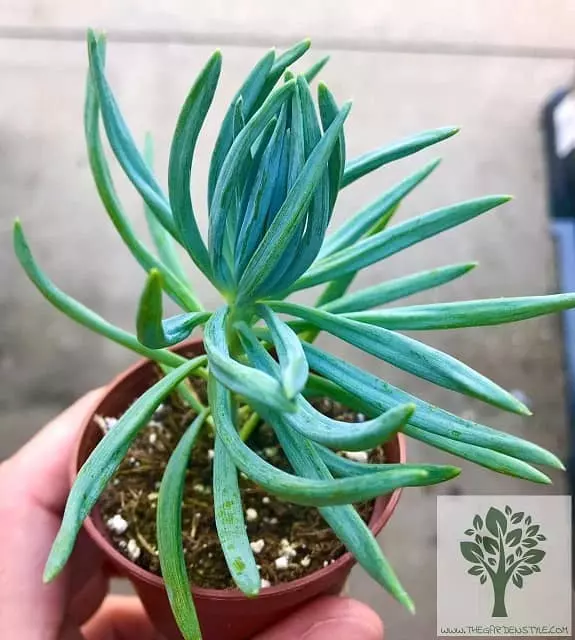The genus Senecio, of the Asteraceae family, includes more than 5,000 species of shrubs, succulents, herbaceous and aquatic plants. In this article, we will talk specifically about how to care for Senecio Serpens (Curio repens).
They are succulent plants with a covering or creeping habit that can produce roots on the stems and do not exceed 12” (30 cm) in height. They have attractive cylindrical fleshy leaves, bluish-green and ending in a point. The flowers are small and cream-colored but are fragrant. They bloom in summer and part of autumn.
Table of Contents
Curio repens Stems and Leaves
This species develops succulent stems of +/- 5” (12 cm) in height with a very conspicuous grayish coloration due to large concentrations of pruina. The leaves are also succulent and arranged alternately on the stems. In addition, they are characterized by having an elongated cylindrical shape with an acute apex and showing a bluish-green or grayish coloration (high concentrations of pruina). The branches of the stems are always axillary and generally appear in low areas of the stems.
Curio repens Flowers
The flowers are small and are arranged in inflorescences in flower heads that arise from the apex of the stems or upper lateral axils; in this case, they are inflorescences of inflorescences with the development of a floral peduncle over 5” (12 cm) in height. The flowers of the inflorescences have 5 white triangular petals; the central bilobed stigma always protruding from the corolla. All flowers are aromatic and exude a very mild pleasant odor.
How to Care Senecio Serpens
Senecio Serpens is very easy to maintain in the garden, below we will explain how to care for Senecio Serpens correctly. If you still don’t have your Senecio Serpens we recommend a place to buy a quality Senecio (Order it here).

Care Senecio Serpens – Light
This plant is perfectly adapted to full sun exposure throughout the day due to its protective pruina. It is recommended to be grown outdoors in bright light to obtain compact plants and blooms. Do not grow in the shade because its stems will etiolate. Even so, it appreciates some shade during the hottest hours of the day in the summer season.
Care Senecio Serpens – Temperature
It prefers to grow under the influence of cool to warm temperatures ranging from 60 to 82°F (16°C to 28°C). Do not expose to temperatures below 32°F (0ºC) for long periods. Frost’s contact with leaves and stems is fatal to this species.
Care Senecio Serpens – Soil
It is important that the soil to be used allows rapid drainage of irrigation water and is very loose. Preferably use commercial substrates for succulent plants and cacti that are offered in numerous nurseries (Order it here).
Good soil for these plants would be commercial cactus soil or a mixture of 50% garden soil and 50% siliceous coarse sand. Adequate soil is the main thing Senecio Serpens needs for proper care. We should never overwater any succulent, this also applies to the correct care of Senecio Serpens.
Care Senecio Serpens – Watering
Water every 3-4 days during the warmer seasons of the year for a good result. In winter it is recommended to water only once a month and if temperatures exceed 59°F (15ºC). Watering always at the height of the soil avoiding strong jets of water against the leaves (they can eliminate the protective pruina).
Curio repens Pests and Diseases
Rarely affected by pests, although mealybugs can invade stems and leaves in exceptional cases. It is a fairly pest-resistant plant in general.
How to Propagate Senecio Serpens
Its propagation is done from cuttings of stems that root very easily. We recommend the use of rooting hormone (Order it here).
To the cutting that we cut, we will have to remove some of its inferior leaves to be able to bury them in the soil. Before placing it in the soil it is convenient to let it heal for two days. On the other hand, we also have to place cinnamon in the wounds.
It is also possible to propagate it by offshoots. It is convenient to carry out this task in summer when the plant is active.
The rooting is favored if the temperatures are kept above 71°F (22ºC).

